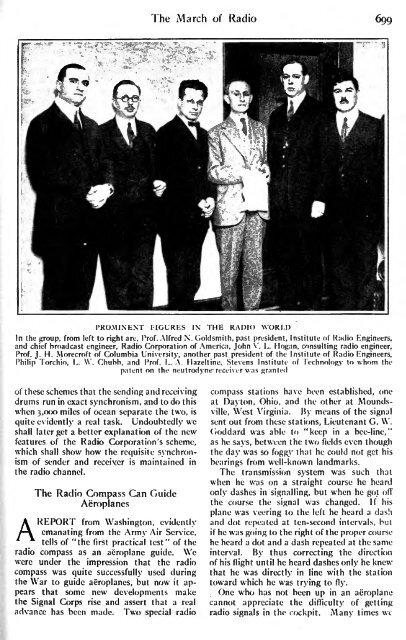Radio Broadcast - 1925, February - 113 Pages ... - VacuumTubeEra
Radio Broadcast - 1925, February - 113 Pages ... - VacuumTubeEra
Radio Broadcast - 1925, February - 113 Pages ... - VacuumTubeEra
You also want an ePaper? Increase the reach of your titles
YUMPU automatically turns print PDFs into web optimized ePapers that Google loves.
The March of <strong>Radio</strong> 699<br />
PROMINENT FIGURES IN THE RADIO WORLD<br />
In the group, from left to right are, Prof. Alfred N. Goldsmith, past president, Institute of <strong>Radio</strong> Engineers,<br />
and chief broadcast engineer, <strong>Radio</strong> Corporation of America, John V. L. Hogan, consulting radio engineer,<br />
Prof. J. H. Morecroft of Columbia University, another past president of the Institute of <strong>Radio</strong> Engineers.<br />
Philip Torchio, L. \V. Chubb, and Prof. L. A. Hazeltine, Stevens Institute of Technology to whom the<br />
patent on the neutrodyne" receiver was granted<br />
of these schemes that the sending and receiving<br />
drums run in exact synchronism, and to do this<br />
when 3,000 miles of ocean separate the two, is<br />
quite evidently a real task. Undoubtedly we<br />
shall later get a better explanation of the new<br />
features of the <strong>Radio</strong> Corporation's scheme,<br />
which shall show how the requisite synchronism<br />
of sender and receiver is maintained in<br />
the radio channel.<br />
A<br />
REPORT<br />
The <strong>Radio</strong> Compass Can Guide<br />
Aeroplanes<br />
from Washington, evidently<br />
emanating from the Army Air Service,<br />
tells of "the first practical test" of the<br />
radio compass as an aeroplane guide. We<br />
were under the impression that the radio<br />
compass was quite successfully used during<br />
the War to guide aeroplanes, but now it<br />
appears<br />
that some new developments make<br />
the Signal Corps rise and assert that a real<br />
advance has been made. Two special radio<br />
compass stations have been established, one<br />
at Dayton, Ohio, and the other at Moundsville,<br />
West Virginia. By means of the signal<br />
sent out from these stations, Lieutenant G. W.<br />
(ioddard was able to "keep in a bee-line,"<br />
as he says, between the two fields even though<br />
the day was so foggy that he could not get his<br />
bearings from well-known landmarks.<br />
The transmission system was such that<br />
when he was on a straight course he heard<br />
only dashes in signalling, but when he got off<br />
the course the signal was changed. If his<br />
plane was veering to the left he heard a dash<br />
and dot repeated at ten-second intervals, but<br />
if he was going to the right of the proper course<br />
he heard a dot and a dash repeated at the same<br />
interval. By thus correcting the direction<br />
of his flight until he heard dashes only he knew<br />
that he was directly in line with the station<br />
toward which he was trying to fly.<br />
One who has not been up in an aeroplane<br />
cannot appreciate the difficulty of getting<br />
radio signals in the cockpit. Many times we
















